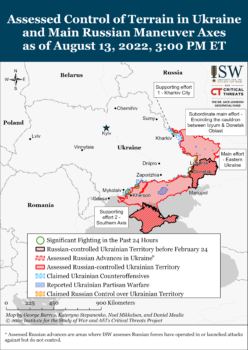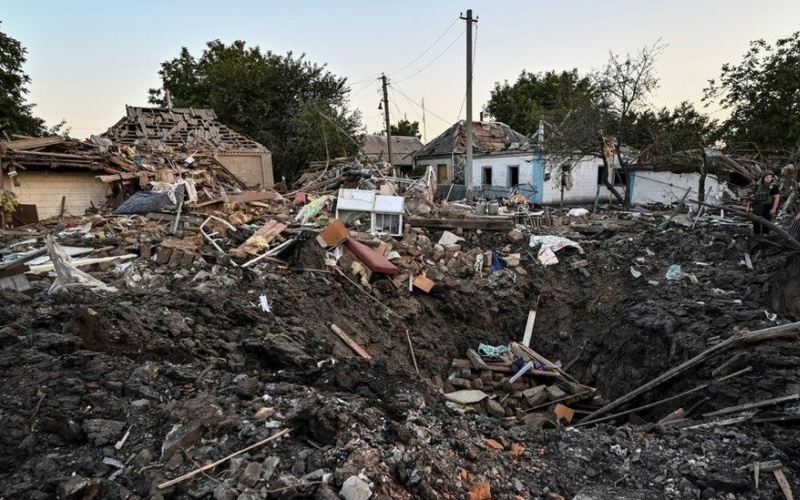Destruction in Chaplyne in eastern Ukraine from a Russian rocket attack, August 24, 2022 (Reuters)
Jump to Original Entry
“Russia Plans to Disconnect Zaporizhzhia Nuclear Plant From Ukraine Electricity Grid”
Wednesday’s Coverage: Ukrainians Mark Independence Day, 6 Months of Resistance v. Putin’s Invasion

Source: Institute for the Study of War
UPDATE 1754 GMT:
After “a great conversation” with US President Joe Biden, Ukraine counterpart Volodymyr Zelenskiy thanked him for “unwavering” support.
On Wednesday, Biden announced almost $3 billion in further military assistance to Ukraine — including anti-aircraft missiles, artillery, counter-drone defences, and radar equipment — bringing the total of American military aid to more than $13 billion.
Had a great conversation with @POTUS. Thanked for the unwavering U.S. support for Ukrainian people – security and financial. We discussed Ukraine’s further steps on our path to the victory over the aggressor and importance of holding Russia accountable for war crimes. pic.twitter.com/4edng8vkvn
— Володимир Зеленський (@ZelenskyyUa) August 25, 2022
UPDATE 1717 GMT:
The last power line to the Russian-occupied Zaporizhzhia nuclear power plant in Ukraine has been restored.
The International Atomic Energy Agency (IAEA) said, “Ukraine told the IAEA that the ZNPP, Europe’s largest nuclear power plant, at least twice lost connection to the power line during the day but that it was currently up again.”
UPDATE 1435 GMT:
The last two working reactors at the Russian-occupied Zaporizhzhia nuclear power plant in southern Ukraine have been shut down after fires damaged overhead power lines.
Ukraine’s state nuclear company Energoatom said, “The actions of the invaders caused a complete disconnection of the Zaporizhzhia Nuclear Power Plant from the power grid – for the first time in the history of the plant.”
The fires are in the ash pits of a nearby coal plant. Energoatom said security systems are working normally and work is underway to reconnect one of reactor blocks to the electricity grid.
See also “Russia Plans to Disconnect Zaporizhzhia Nuclear Plant From Ukraine Electricity Grid”
UPDATE 1430 GMT:
Russian shelling killed a 17-year-old boy in the town of Orikhiv in the Zaporizhzhia region in southern Ukraine.
Oleksandr Starukh, the head of the Zaporizhzhia regional military administration, said the Russians attacked for several hours. The teenager was seriously wounded and died on the way to hospital. A 66-year-old woman in the village of Preobrazhenka was seriously injured.
Dozens of private houses were destroyed, said Starukh.
UPDATE 1208 GMT:
Russian troops have widely used cluster bombs in their invasion of Ukraine, causing hundreds of civilian casualties and damaging homes, schools and hospitals, reports the Cluster Munition Coalition.
Mary Wareham, an advocacy director at Human Rights Watch, summarized, “Russia’s extensive use of internationally-banned cluster munitions in Ukraine demonstrates a blatant disregard for human life, humanitarian principles and legal norms.”
UPDATE 1151 GMT:
The head of the International Atomic Energy Agency, Rafael Grossi, says the IAEA is “very, very close” to being able to visit the Russian-occupied Zaporizhzhia nuclear power plant in southern Ukraine.
Grossi said the operation is “extremely complex”, hoping it will be carried out within “days”.
Russian Defense Minister Sergey Shoygu discussed the issue by phone with his French counterpart Sébastien Lecornu on Thursday.
UPDATE 0831 GMT:
The death toll has risen to 25 from the Russian strikes on Chaplyne in eastern Ukraine.
Among the victims is a 6-year-old child, killing in a burning car near the railway station that was targeted.
The European Union’s foreign policy head Josep Borrell has condemned the Russian killings:
The EU strongly condemns another heinous attack by Russia on civilians: in #Chaplyne on #UkraineIndependenceDay.
Those responsible for Russian rocket terror will be held accountable.
— Josep Borrell Fontelles (@JosepBorrellF) August 25, 2022
US Secretary of State Antony Blinken added:
Russia’s missile strike on a train station full of civilians in Ukraine fits a pattern of atrocities. We will continue, together with partners from around the world, to stand with Ukraine and seek accountability for Russian officials.
— Secretary Antony Blinken (@SecBlinken) August 24, 2022
Russia’s Defense Ministry insisted the rockets struck a military train carrying weapons to the frontline in the Donetsk region.
UPDATE 0739 GMT:
On Wednesday, Russia Defense Minister Sergey Shoygu claimed at a Shanghai Cooperation Organization meeting in Uzbekistan, “Everything is being done to avoid casualties among civilians. Of course, this slows down the pace of the offensive, but we are doing this deliberately.”
The Institute for the Study of War puts the statement in context:
Russian forces have lost an area larger than Denmark since the high-water mark of their invasion of Ukraine in mid-March and gained an area the size of Andorra (one percent of what they have lost) in the last 39 days.
UPDATE 0726 GMT:
Russia fired two missiles on the Vyshgorod district in northern Kyiv about 3 a.m. on Thursday morning.
The head of the regional military administration, Oleksiy Kuleba, said there are no casualties, or damage to residential buildings or infrastructure facilities, so far.
In south-central Ukraine, eight people, including three children, have been injured in Synelnykove by Russian shelling.
UPDATE 0722 GMT:
A New Zealand soldier, Cpl. Dominic Abelen, has been killed in Ukraine.
Abelen, 30, was on leave without pay after enlisting with Ukraine’s International Legion. A 10-year veteran, he had served in Iraq.
The corporal did not tell the New Zealand military that he was travelling to Ukraine.
ORIGINAL ENTRY: A Russian strike has killed at least 22 people, including an 11-year-old boy, and injured 50 in eastern Ukraine on the country’s Independence Day.
Ukrainian official had warned of Russian attacks on Wednesday, with ceremonies cancelled in Kyiv. The capital was unscathed yesterday, but rockets hit the town of Chaplyne, about 145km (90 miles) west of Donetsk.
An initial Russian strike killed the boy in his home. The follow-up attack hit the railway station, destroying five train carriages and slaying another 21 people.
Ukraine President Volodymyr Zelenskiy told the UN of the attack:
Rescuers are working, but, unfortunately, the death toll could increase….
Chaplyne is our pain today. As of this moment, there are 22 dead, five of them burned in the car. An 11-year-old teenager died.
Russian occupiers have repeatedly struck civilian areas throughout their invasion, including deadly strikes on railway strikes. In mid-April, a missile killed 57 civilians at the Kramatorsk station in eastern Ukraine.
See Ukraine War, Day 45: Russia’s “Murderous Deliberate Slaughter” at Kramatorsk Railway Station
Some photos coming in of the Russian strike on a railway station in Сhaplyne (between Donetsk and Dnipro). Zelensky said that there are at least 15 killed/50 wounded, making it one of the deadliest single strikes since the Russian strike on Kramatorsk.https://t.co/n3DWJlPaeU pic.twitter.com/aoxjeqByXV
— Aric Toler (@AricToler) August 24, 2022

